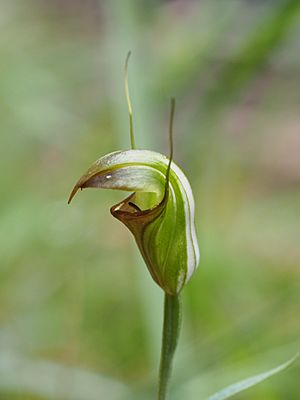Collared greenhood facts for kids
Quick facts for kids Collared greenhood |
|
|---|---|
 |
|
| Pterostylis torquata growing at Apsley Falls | |
| Scientific classification | |
| Genus: |
Pterostylis
|
| Species: |
torquata
|
| Synonyms | |
|
Diplodium torquatum (D.L.Jones) D.L.Jones & M.A.Clem. |
|
The collared greenhood (scientific name: Pterostylis torquata) is a special type of orchid. It is found only in New South Wales, Australia. This means it is endemic to that area.
Like other greenhood orchids, this plant looks different depending on if it is flowering or not. When it's not flowering, it has a group of leaves that lie flat on the ground. This group of leaves is called a rosette. When it is flowering, it grows a single flower on a stem. The flower is usually white with dark green and dark brown patterns. Sometimes, the brown patterns are missing. A unique part of the flower, called the sinus, looks like a small platform.
Contents
What Does the Collared Greenhood Look Like?
The collared greenhood is a plant that grows from an underground tuber (like a small potato). It is a perennial plant, meaning it lives for more than two years. It is also deciduous, so its leaves fall off at certain times.
When the plant is not flowering, it has a rosette of dark green leaves. These leaves lie flat on the ground. Each leaf is about 15 to 25 millimeters (about 0.6 to 1 inch) long. They are also about 10 to 15 millimeters (about 0.4 to 0.6 inches) wide.
Flowering Stem and Flower Details
When the plant flowers, it grows a single, straight stem. This stem can be 100 to 200 millimeters (about 4 to 8 inches) tall. It has three to five leaves spread along it. The flower itself is about 18 to 21 millimeters (about 0.7 to 0.8 inches) long. It is about 7 to 9 millimeters (about 0.3 inches) wide.
The flower is usually white with dark green and dark brown markings. The top part of the flower, called the dorsal sepal, joins with the petals. Together, they form a hood-like shape over the central part of the flower, which is called the column. The dorsal sepal has a short point at its tip.
The side parts of the flower, called the lateral sepals, have thin, thread-like tips. These tips stand upright and are about 15 to 20 millimeters (about 0.6 to 0.8 inches) long. The area between these lateral sepals, known as the sinus, sticks out like a platform. This part is usually dark brown.
The labellum is another part of the flower. It is curved and looks blackish. It is about 9 to 11 millimeters (about 0.35 to 0.43 inches) long and about 3 millimeters (about 0.12 inches) wide. You can just see it peeking out above the sinus.
When Does It Flower?
The collared greenhood usually flowers between February and May.
How Was This Orchid Named?
The collared greenhood was officially described in 1997. A botanist named David Jones gave it its scientific name, Pterostylis torquata. He found a sample of the plant in the Northern Tablelands. The name was published in a journal called The Orchadian.
The second part of its scientific name, torquata, comes from a Latin word. It means "adorned with a necklace or collar." This likely refers to the unique shape of the flower.
Where Does the Collared Greenhood Live?
The collared greenhood grows in forests. It is found in the area known as the Northern Tablelands in New South Wales.

